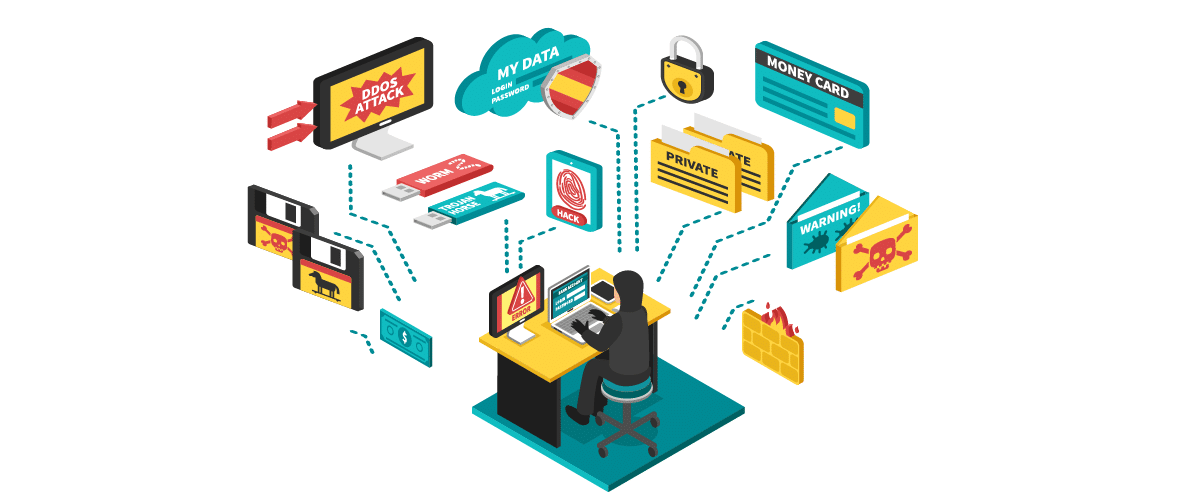
DNS security issues
DNS protocol is fundamental to everyday internet use and is, therefore, a favorite target of hackers. In this post, we will outline the main security issues related to DNS protocol and show how FlashStart helps businesses, households, and organizations to combat DNS attacks.
1. What DNS protocol is
DNS stands for Domain Name System and is considered the telephone book of the internet. It grew out of the need to link the names of sites, which we remember relatively easily, to their IP addresses, in other words, the Internet Protocol addresses of each individual site.
The need for this connection is explained by the fact that, even if we remember the name of a site, the internet protocol recognizes only numeric addresses. In this setting, the DNS protocol deals precisely with the conversion of the name we remember into a number, so that we can reach the desired internet site.
The DNS protocol works very quickly because it relies on pre-existing and constantly updated domain mappings. This way the user does not even notice the “translation” process from letters to numbers, and, once the site name is typed in, the DNS resolver looks it up in its local cash or, if not available locally, queries a DNS server directly and then redirects the user to the site. This all happens in fractions of a second.
>> FlashStart protects you from a wide array of threats and blocks access to malicious sites → Request a quotation or try it now
2. Why attack DNS protocol?
The DNS protocol is a fundamental service for large-scale public usage of the internet. In fact, most communications, exchanges, and information require this protocol in order to be completed. If the resolving service is unavailable or malfunctioning, the service interruption can affect a wide variety of sites and applications, with extensive chain reactions.
According to the Global DNS Threat Report del 2021, conducted by IDC (International Data Corporation), eighty-seven percent of the organizations analyzed in 2021 were the target of DNS attacks which cost the victim organizations an average of $950,000. The attacks that resulted in the highest costs were those toward organizations based in North America, while the largest increases in damages on a geographical level were in Malaysia, India, Spain, and France.
The report also points out that, during the pandemic years, corporate clouds have increasingly become the target of attacks, as hackers have taken advantage of the increased tendency to use infrastructure and services which allow for remote work. Forty-seven percent of companies report experiencing disruptions in access to the cloud and related services due to DNS security issues.
Finally, the report highlights a marked increase in data theft through DNS protocol attacks. Specifically, twenty-six percent of organizations reported experiencing such theft in 2021, a figure that stood at only sixteen percent in the previous year.
>> FlashStart is the ideal ally for dealing with DNS security issues → Request a quotation or try it now
3. Types of DNS attacks
DNS attacks may vary in nature. Below, we propose a view of the most common types of attacks related to DNS security issues.
3.1 DNS tunneling
DNS tunneling is a DNS attack technique which allows the cyber criminal to create a link to the victim’s computer, a veritable tunnel between the hacker’s computer and the target computer, which is then used to exfiltrate data and information.
The hacker infects the intended victim’s computer with malware, but it is difficult to detect because it does not block DNS requests. The user then continues to send requests to the DNS resolver in order to obtain IP addresses, but the resolver forwards the requests to the criminal’s server, whence the tunneling then begins: a “secure” corridor is created with the victim’s computer and accessed for malicious purposes.
3.2 Amplification of DNS
DNS amplification is a type of DNS attack that is part of the category of DDoS – Distributed Denial of Service attacks. In these attacks, the cyber criminal targets a public DNS resolver to overwhelm the victim with DNS traffic.
When the victim requests the IP address of a site, the hacker likewise does the same, but his request generates data packets of a magnitude that overloads the server to the point that it is no longer able to respond to legitimate user requests.
3.3 UDP flood attacks
UDP flood attacks are also DoS-type attacks meant to overload the target server. In this case, the attack exploits the User Datagram Protocol (UDP- a protocol characterized by making data transmission as brief as possible by waiving certain checks.
During a UDP attack, the cyber criminal sends UDP packets with fake sender IP addresses to random ports on the victim’s system. The UDP packet then checks to see if there are any applications listening on the chosen port but, since the sending is random, this is usually not the case. It must then send an ICMP – Internet Control Message Protocol – packet to the sender’s address to inform him of the problem, but, since the sender’s address has been spoofed, these packets end up at a third, uninvolved party.
By flooding the victim with UDP packets, the hacker overloads the target website or service until it collapses under the weight of all the incoming data.
>> Are you an appliance manufacturer? It is possible to natively integrate FlashStart → Request a quotation or try it now
4. FlashStart prevents DNS security issues
Given the pervasiveness and effects of the attacks described above, it is important to prevent them by confronting DNS security problems at the source: that is, acting directly at the DNS level. FlashStart proposes a DNS-based web filter that intercepts and blocks all suspicious requests, ensuring the security of your network, information, and computer systems.
4.1 FlashStart: security at the DNS level
FlashStart’s filtering system acts at the DNS level: when a user types in the name of the site that he or she wants to reach, FlashStart’s web filter verifies the user’s request and, based upon the outcome of this verification, chooses whether or not to allow the requested domain to be resolved. This is, therefore, referred to as DNS threat intelligence, a security analysis aimed at highlighting DNS-based web threats.
FlashStart’s DNS threat intelligence is based on predetermined lists available in the FlashStart cloud, a repository that contains millions of sites categorized by their content and divided into dangerous, inappropriate, and distracting. If the site the user wants to access is among those that are dangerous, linked to malware, phishing attempts, and other types of cyber attacks, the web filter blocks the domain from being resolved.
4.2 FlashStart: artificial intelligence in the service of cybersecurity
In order to properly analyze websites and introduce them within the lists in the cloud, FlashStart constantly scans the internet using artificial intelligence, a complex mechanism of mathematical algorithms based upon neural networks which imitate human reasoning and make decisions regarding the dangerousness or otherwise of the scanned material.
Thanks to artificial intelligence, FlashStart is able to analyze and correctly catalog up to 200 thousand new sites every day in twenty-four different languages, ensuring continuous updating. Machine learning mechanisms then allow the system to learn from its previous experiences and, thereby, speed up analysis with increasingly accurate results.
The cloud also ensures that updates are always instantly available to the end user, so, once a threat is highlighted, all FlashStart users are automatically protected from it without the need to download any kind of update or go through lengthy system reboots.
>> FlashStart is totally in the Cloud, constantly updated, and easy to activate → Request a quotation or try it now
4.3 FlashStart: the solution to DNS security issues
FlashStart’s filtering system can be installed at the router level, providing protection for all devices connected to the network, or at the individual device level via the ClientShield application, protecting all workers in the organization, even those connected remotely.
Once installed, FlashStart works autonomously, blocking suspicious incoming and outgoing traffic, whether in the form of the UDP packets, as described above, links to malicious contents from third parties, or sites searched by the user.
4.4 FlashStart: not only malware
However, FlashStart does not only block malware and malicious contents. The system can also be set by the network administrator to block access to:
» Inappropriate contents: these are contents related to pornography, online gambling, violence, drugs, etc., deemed inappropriate for the environment from which the internet is accessed.
» Distracting contents: these are social networks, streaming and audio content platforms, online shopping sites, and all those sites that can cause workers’ efficiency to decline.
>> FlashStart is the leader in cloud Internet Security and protects you against malware and undesired content → Request a quotation or try it now
You can activate the FlashStart® Cloud protection on any sort of Router and Firewall to secure desktop and mobile devices and IoT devices on local networks.









